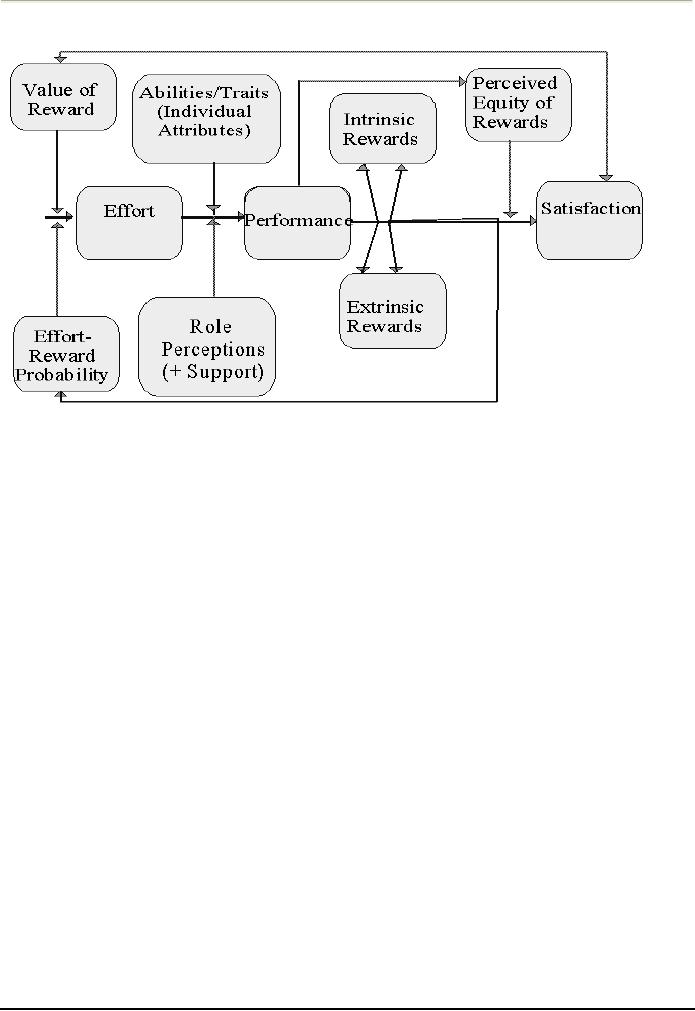 |

Organizational
Psychology (PSY510)
VU
LESSON
21
THEORIES
OF MOTIVATION
Victor
Vroom's Expectancy Theory of
Motivation
The
Expectancy Theory of Victor
Vroom deals with motivation
and management. Vroom's
theory
assumes
that behavior results from
conscious choices among alternatives
whose purpose it is to
maximize
pleasure and minimize pain.
Together with Edward Lawler
and Lyman Porter,
Vroom
suggested
that the relationship
between people's behavior at
work and their goals
was not as simple
as
was first imagined by other
scientists. Vroom realized
that an employee's performance is
based
on
individuals factors such as personality,
skills, knowledge, experience and
abilities.
�
The
expectancy theory says that
individuals have different
sets of goals and can
be
motivated
if they believe that:
�
There
is a positive correlation between efforts
and performance,
�
Favorable
performance will result in a
desirable reward,
�
The
reward will satisfy an important
need,
�
The
desire to satisfy the need
is strong enough to make the
effort worthwhile.
Vroom's
Expectancy Theory is based
upon the following three
beliefs:
Valence
(Valence
refers to the emotional
orientations people hold
with respect to outcomes
[rewards].
The depth of the want of an
employee for extrinsic
[money, promotion,
time-off,
benefits]
or intrinsic [satisfaction] rewards).
Management must discover what
employees value.
Expectancy
(Employees have different expectations
and levels of confidence about
what they are
capable
of doing). Management must discover
what resources, training, or supervision
employees
need.
Instrumentality
(The
perception of employees whether they
will actually get what
they desire
even
if it has been promised by a manager).
Management must ensure that
promises of rewards
are
fulfilled
and that employees are
aware of that.
Vroom
suggests that an employee's
beliefs about Expectancy,
Instrumentality, and Valence
interact
psychologically
to create a motivational force such
that the employee acts in
ways that bring
pleasure
and avoid pain. This force
can be 'calculated' via the
following formula:
Motivation
= Valance x Expectancy
(Instrumentality)
This
formula can be used to
indicate and predict such things as
job satisfaction, one's
occupational
choice,
the likelihood of staying in a
job, and the effort one
might expend at work.
72

Organizational
Psychology (PSY510)
VU
Porter-Lawler
Model
The
process theory called the
Porter-Lawler Model suggests
that levels of motivation
are based
more
on the value that individuals
place on the reward. The
components that effect
motivation
then,
are called valence (what's
important to you) and
expectancy (can I do it).
Porter and Lawler
suggest
that perceived inequality in
this model plays a pivotal
role in job satisfaction.
Our
motivation,
or effort leads to performance. Our
performance is followed by intrinsic
and extrinsic
rewards.
The perceived equity of those
rewards leads to satisfaction.
The
model of ties in Vroom's
Expectancy Theory, roles and
traits, intrinsic and extrinsic
rewards
as
well as satisfaction. Porter and
Lawler suggest that employee
effort is jointly determined by
two
key
factors: the value placed on certain outcomes by
the individual, and the
degree to which the
person
believes that his effort
will lead to the attainment
of these rewards. However,
the person's
ability
and role clarity may
prevent performance, thus, managers
must assign people to tasks
where
ability
fits the requirements.
Porter
and Lawler use satisfaction in
their model. Satisfaction
raises several interesting
thoughts
regarding
managers' motivation of employees. We
define "satisfaction" as needs being
met. Think
about
it, if needs are met,
what is the purpose of behavior?
The same holds true
for "happy."
Managers
want to believe that happy,
satisfied employees are the
most productive. There is
no
reputable
research which confirms
this.
Stacy
Adams'S Equity
theory
John
Stacey Adams, workplace and
behavioural psychologist, put forward his
Equity Theory on
job
motivation in 1963.
We
each seek a fair balance
between what we put into
our job and what we
get out of it.
Adams
calls
these inputs and outputs. We
form perceptions of what constitutes a
fair balance or trade
of
inputs
and outputs by comparing our
own situation with other
'referents' (reference points or
examples)
in the market place. We are
also influenced by colleagues,
friends, partners in
establishing
these benchmarks and our own
responses to them in relation to
our own ratio of
inputs
to outputs.
73

Organizational
Psychology (PSY510)
VU
Outputs
are typically all
financial
rewards
- pay, salary, expenses,
Inputs
are typically: effort,
loyalty,
perks,
benefits,
pension
hard
work, commitment, skill,
ability,
People
need to feel arrangements,
bonus
and
adaptability,
flexibility, tolerance,
that
there is a fair commission - plus
intangibles -
determination,
heart and soul,
balance
between
recognition, reputation, praise
and
enthusiasm,
trust in our boss
and
inputs
and outputs. thanks,
interest, responsibility,
superiors,
support of colleagues
and
stimulus,
travel,
training,
subordinates,
personal sacrifice,
etc.
development,
sense of achievement
and
advancement, promotion, etc.
If
we feel are that inputs are
fairly and adequately
rewarded by outputs (the
fairness benchmark
being
subjectively perceived from market
norms and other comparables
references) then we
are
happy
in our work and motivated to
continue inputting at the
same level.
If
we feel that our inputs
out-weigh the outputs then
we become demotivated in relation to our
job
and
employer. People respond to this feeling
in different ways: generally the
extent of
demotivation
is proportional to the perceived
disparity between inputs and
expected outputs.
Some
people reduce effort and
application and become inwardly
disgruntled, or outwardly
difficult,
recalcitrant or even disruptive. Other
people seek to improve the
outputs by making
claims
or demands for more reward, or
seeking an alternative
job.
Attribution
Theory: Kelly
Human
beings are rational and
are motivated to identity, understand
and change the
environment.
Perception
and not actual world
govern motivation. Locus of internal or
external control
creates
motivation.
According to attribution theory,
the explanations that people
tend to make to
explain
success
or failure can be analyzed in terms of
three sets of
characteristics:
First,
the cause of the success or
failure may be internal or
external. That is, we may
succeed or fail
because
of factors that we believe
have their origin within us
or because of factors that originate
in
our
environment.
Second,
the cause of the success or
failure may be either stable or unstable.
If the we believe
cause
is
stable, then the outcome is
likely to be the same if we
perform the same behavior on
another
occasion.
If it is unstable, the outcome is likely
to be different on another
occasion.
Third,
the cause of the success or
failure may be either
controllable or uncontrollable. A
controllable
factor is one which we believe we
ourselves can alter if we wish to do
so. An
uncontrollable
factor is one that we do not
believe we can easily
alter.
The
basic principle of attribution
theory as it applies to motivation is
that a person's own
perceptions
or attributions for success or
failure determine the amount of
effort the person
will
expend
on that activity in the
future.
There
are four factors related to
attribution theory that
influence motivation: ability,
task difficulty,
effort,
and luck. In terms of the
characteristics discussed previously,
these four factors can
be
analyzed
in the following way:
Ability
is a relatively internal and
stable factor over which
the learner does not
exercise much direct
control.
Task
difficulty is an external and
stable factor that is largely
beyond the learner's
control.
Effort
is an internal and unstable factor
over which the learner can
exercise a great deal of
control.
Luck
is an external and unstable factor
over which the learner
exercises very little
control.
Emerging
Theories
Control
Theory
Control
theory relates to feeling that
employees are in full
control of their lives, or are in
control of
their
jobs. Recent studies have
shown that those who
believe they have such
personal control
74

Organizational
Psychology (PSY510)
VU
tolerate
unpleasant events and experience less
stress on the job than those
who do not perceive
such
control.
Agency
Theory
According
to the Agency Theory, the interest of
the organization and
individuals may clash
resulting
in lesser motivation of the
employees. Problems relating to clash
between interests of
individuals
and the organization are
known as agency problems.
REFERENCES
Porter
Lawler Model:
http://www.people.vcu.edu/~rsleeth/Porter1.html
Cognitive
Aspects of Motivation
http://education.calumet.purdue.edu/vockell/EdPsyBook/Edpsy5/Edpsy5_needs.htm
Physiological
Aspects of Motivation
http://education.calumet.purdue.edu/vockell/EdPsyBook/Edpsy5/Edpsy5_physiological.htm
FURTHER
READING
Learning
from Poor and Minority
Students Who Succeed in School by
Janine Bempechat
http://www.units.muohio.edu/psybersite/workplace/motivation.shtml
http://www.luebasedmanagement.net/methods_vroom_expectancy_theory.html
Motivation:
http://education.calumet.purdue.edu/vockell/EdPsyBook/Edpsy5/Edpsy5_motivation.htm
75
Table of Contents:
- INTRODUCTION TO ORGANIZATIONAL PSYCHLOGY:Hawthorne Effect
- METHODOLOGIES OF DATA COLLECTION:Observational method, Stability of Measures
- GLOBALIZATION:Aspects of Globalization, Industrial Globalization
- DEFINING THE CULTURE:Key Components of Culture, Individualism
- WHAT IS DIVERSITY?:Recruitment and Retention, Organizational approaches
- ETHICS:Sexual Harassment, Pay and Promotion Discrimination, Employee Privacy
- NATURE OF ORGANIZATIONS:Flat Organization, Neoclassical Organization Theory
- ORGANIZATIONAL CULTURE:Academy Culture, Baseball Team Culture, Fortress Culture
- CHANGING ORGANIZATIONAL CULTURE:Move decisively, defuse resistance
- REWARD SYSTEMS: PAY, Methods of Pay, Individual incentive plan, New Pay Techniques
- REWARD SYSTEMS: RECOGNITION AND BENEFITS, Efficiency Wage Theory
- PERCEPTION:How They Work Together, Gestalt Laws of Grouping, Closure
- PERCEPTUAL DEFENCE:Cognitive Dissonance Theory, Stereotyping
- ATTRIBUTION:Locus of Control, Fundamental Attribution Error
- IMPRESSION MANAGEMENT:Impression Construction, Self-focused IM
- PERSONALITY:Classifying Personality Theories, Humanistic/Existential
- PERSONALITY ASSESSMENT:Standardized, Basic Categories of Measures
- ATTITUDE:Emotional, Informational, Behavioural,Positive and Negative Affectivity
- JOB SATISFACTION:The work, Pay, Measurement of Job Satisfaction
- MOTIVATION:Extrinsic motive, Theories of work motivation, Safety needs
- THEORIES OF MOTIVATION:Instrumentality, Stacy Adams’S Equity theory
- MOTIVATION ACROSS CULTURES:Meaning of Work, Role of Religion
- POSITIVE PSYCHOLOGY:Criticisms of ‘Traditional’ Psychology, Optimism
- HOPE:Personality, Our goals, Satisfaction with important domains, Negative affect
- EMOTIONAL INTELLIGENCE:EI IS Related To Emotions and Intelligence
- SELF EFFICACY:Motivation, Perseverance, Thoughts, Sources of Self-Efficacy
- COMMUNICATION:Historical Background, Informal-Formal, Interpersonal Communication
- COMMUNICATION (Part II):Downward Communication, Stereotyping Problems
- DECISION MAKING:History, Personal Rationality, Social Model, Conceptual
- PARTICIPATIVE DECISION MAKING TECHNIQUES:Expertise, Thinking skills
- JOB STRESS:Distress and Eustress, Burnout, General Adaptation Syndrome
- INDIVIDUAL STRESSORS:Role Ambiguity/ Role Conflict, Personal Control
- EFFECTS OF STRESS:Physical Effects, Behavioural Effects, Individual Strategies
- POWER AND POLITICS:Coercive Power, Legitimate Power, Referent Power
- POLITICS:Sources of Politics in Organizations, Final Word about Power
- GROUPS AND TEAMS:Why Groups Are Formed, Forming, Storming
- DYSFUNCTIONS OF GROUPS:Norm Violation, Group Think, Risky Shift
- JOB DESIGN:Job Rotation, Job Enlargement, Job Enrichment, Skill Variety
- JOB DESIGN:Engagement, Disengagement, Social Information Processing, Motivation
- LEARNING:Motor Learning, Verbal Learning, Behaviouristic Theories, Acquisition
- OBMOD:Applications of OBMOD, Correcting Group Dysfunctions
- LEADERSHIP PROCESS:Managers versus Leaders, Defining Leadership
- MODERN THEORIES OF LEADERSHIP PROCESS:Transformational Leaders
- GREAT LEADERS: STYLES, ACTIVITIES AND SKILLS:Globalization and Leadership
- GREAT LEADERS: STYLES, ACTIVITIES AND SKILLS:Planning, Staffing